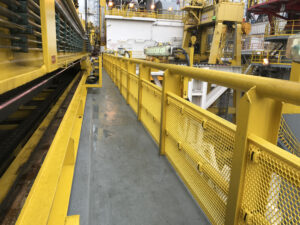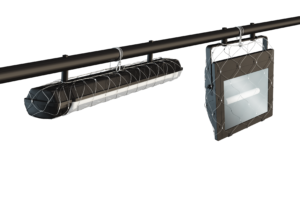Use of tools like barriers, nets and pouches can help to mitigate risk of dropped object incidents in offshore drilling operations
By Mike Rice, Dropsafe
The Oil & Gas industry has been through a few years of low prices and fluctuations in rig utilization. However, even as drilling contractors face depressed dayrates, they must maintain focus on improving operational efficiency and safety. This encompasses continually enhancing safety standards and adopting innovative technologies.
One of the biggest safety hazards in drilling operations is the risk of dropped objects. In recent years, many drilling contractors have taken pioneering steps to mitigate drops. This has primarily been seen through the installation of drops prevention technologies, including secondary retention devices and barrier systems on drilling rigs and other facilities where employees might work at height.
Drops incidents are still occurring globally, however, with significant impact on safety, finances and reputation.
In October 2019, a Canadian oil and gas vessel saw a drops incident with high potential to cause a fatality. Luckily, there were no personnel in the area at the time. The drop was caused by a failed sling, demonstrating the importance of investing in high-quality drops solutions.

This incident follows an upstream oil and gas company in Australia being forced to halt operations of one of its vessels following a drops incident that was of sufficient height and weight to cause a fatality, if an engineer been working beneath. Thankfully, no personnel were harmed in that incident, but when operations are put on pause, costs are incurred from downtime and the extension of equipment hire.
The incident in Australia was reportedly caused by the vessel being in a “degraded state,” with multiple failed structural elements resulting in the drop. Degradation of assets in offshore oil and gas can be caused by harsh environments, including high winds and vibration from drilling operations, causing structures to corrode and weaken.
The investigation that took place following this incident concluded that the vessel operators failed to demonstrate integrity of safety-critical equipment. As a result, the company will not only see an impact on profitability while production is halted but also significant costs as it works with a regulatory body to resolve the health and safety failings onboard the vessel. As the incident has been reported in the media, the company faces a negative impact on its reputation for safe operation.
These recent incidents – while they do not involve fatalities – illustrate that the industry is still in need of practical guidance on how to improve their operational safety. Safeguarding personnel is vital, but mitigating financial and reputation risks is also essential to maintain profitability in an environment where contractors are operating under strict budgets.
Technologies to mitigate drops
In light of the impact that exposure to extreme conditions can have on drillships and platforms, it is important that drilling contractors install drops prevention technologies that will stand up to these harsh environments.
Barrier systems
Barrier systems can be installed to railings on stairways, raised working platforms and walkways where tools are being used during normal operations and maintenance operations. This prevents tools that are dropped to the floor from being knocked or kicked off the platform. Drops incidents of this kind can result in objects falling into the sea, hitting the floor below, or striking a worker when operations are taking place.

Drilling contractors operating offshore need barriers that withstand impacts, vibration and corrosion in order to perform effectively. The risk of corrosion, in particular, mandates that robust drops solutions are installed, since the barrier will be exposed to severe conditions.
Saltwater will significantly increase corrosion for metal-based products, requiring high maintenance recoatings for protection. Extreme weather could include sub-zero temperatures or hot and humid conditions, as well as high wind speeds. Finally, strong exposure to UV radiation will degrade many materials over time, making this a key factor for long-term cost-effective drops solutions.
Perceived costs shouldn’t impede safe drops prevention, however. It might be tempting to choose a superficially cheaper option to reduce immediate capital expenditure, but this may not be the most cost-effective solution in terms of long-term operational overheads. It is important to consider the cumulative cost of using the product over a given period.
For example, stretched metal barriers require extensive hot works during installation, requiring the rig to be shut down to avoid the risks stemming from using welding equipment in such close proximity to hydrocarbons.
Indeed, when barriers are used for years and suffer degradation from corrosion, spending associated with partial or full replacement of the product, maintenance and the associated manpower may be significantly more than the initial material and installation outlays. More robust and versatile solutions might have a higher upfront price but require no replacement and minimal maintenance over their lifecycle.
Nets
Drilling rigs are subject to high levels of vibration, which significantly increases the risk of drops incidents by loosening brackets. Light fixtures, CCTV cameras, speakers and other fixtures are in danger of being dislodged over time, presenting hazards to personnel and equipment.

This is especially relevant in harsh offshore environments, where corrosion and extreme weather can act in tandem with strong vibration to compromise the structural integrity of fixtures. There is also a risk of jarring impacts during routine operations, such as crane booms striking fixtures and transfer vessels “pushing on,” which could knock objects from their mountings.
Additionally, even if proper training procedures are followed, human error can still lead to drops incidents, with inadequately secured and improperly installed fixtures posing a particular risk. These risks can be mitigated by using high-quality steel mesh net, which securely encloses objects and tethers them onto more secure structures.
In one case, the Dropsafe Net was used to secure a large floodlight, which was found on inspection to have suffered corrosion. This meant that the impact guard and light shade had fallen off. Due to the net, the broken components were prevented from dropping a considerable distance, removing the potential for asset damage or personnel injury.
Similar to barriers, buying cheaper, less robust nets or attempting makeshift solutions can prove to be a false economy when longer term cost-effectiveness is considered.
The use of “slings” has been common in the past, but it is increasingly recognized that effective drops prevention requires fixtures to be fully enclosed. High-quality nets will include an integrated securing cable to wrap around an attachment point, providing an extra layer of security.
Pouches
A third critical drops prevention solution relates to smaller items, such as tools carried by personnel. A pouch is a secondary securing device consisting of steel wire mesh, which securely tethers equipment to personnel working at height. This prevents equipment, such as two-way radios, multi-meters and aerosol canisters, from being knocked or dropped from raised working areas and becoming a dropped object.
The true scale of this type of drops incident is likely to be higher than statistics suggest, due to underreporting of near-misses and low-potential incidents. It only takes one fatal incident to tarnish a company’s reputation, to say nothing of the damage high-potential incidents can cause to critical infrastructure.
Lost or damaged tools have the potential to cause project delays, in addition to the obvious costs of equipment replacement. This is before factoring in any costs from asset damage or personnel injury caused by a drops incident. A robust secondary securing system will mitigate this risk. Best practice is to ensure that all personnel working at height are issued and trained with secondary securing devices. This ensures dropped equipment will not become a potentially deadly hazard.
Conclusion
The oil and gas industry has made progress in drops prevention, setting a bar for self-regulation that other industries in the offshore energy sector can seek to emulate. Until the number of drops incidents reaches zero, there will always be more to do to ensure that drops prevention best practice is followed by all parts of the industry. Drilling contractors must play their role here and will be rewarded with a sound reputation, reduced damage to assets and equipment, and, above all, the safety of their personnel. DC




